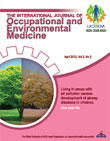فهرست مطالب

International Journal of Occupational and Environmental Medicine
Volume:3 Issue: 2, Apr 2012
- تاریخ انتشار: 1391/01/22
- تعداد عناوین: 9
-
-
Page 53BackgroundThere are inconsistencies about the effects of farmworker housing and workplace conditions and use of self-protective behavior practices and personal protective equipment (PPE).ObjectiveTo investigate the association between workplace and housing conditions and farmworker use of pesticide safety practices and PPE.MethodsThis study was conducted in 4 counties in North Carolina, USA, from July to October, 2010, during the agricultural growing season. Farmworkers working in agriculture aged 18 to 62 (n=187) were administered a structured questionnaire to collect self-reported measures on housing and workplace conditions. Use of pesticide safety and PPE were examined by asking questions about wearing gloves, wearing socks, and wearing a hat. Chi-square and multiple logistic regression analyses were used for statistical analyses.ResultsFarmworkers reporting availability of enough hot and cold water for bathing and doing laundry were 13.6 times more likely to use pesticide safety practices (adjusted OR: 13.6, 95% CI: 1.4–135.4), whereas, those who reported that soap for handwashing was always or usually available while doing agricultural work were 7.8 times more likely to use pesticide safety practices (adjusted OR: 7.8, 95% CI: 3.3–18.5). Farmworkers that reported access to water to wash their hands with while performing agricultural work were more likely to use PPE (adjusted OR: 3.4, 95% CI: 1.3–9.2).ConclusionsSome migrant farmworker labor camps are not supplying acceptable housing conditions such as 1 handwashing sink per 6 people (n=10, 5.4%). Use of pesticide safety practices and PPE is greater when farmers provide decontamination supplies. Improvement of housing and workplace conditions are crucial to increase use of pesticide safety practices and PPE.
-
Page 68BackgroundIt has been shown that inhalation of carbonaceous particulate matter may impair lung function in children.ObjectiveUsing the carbon content of airway macrophages as a marker of individual exposure to particulate matter derived from fossil fuel, we sought direct evidence for this association.Methods300 children from puffed rice industrial areas and 300 children from population living in green zone were selected randomly. Airway macrophages were obtained from healthy children through sputum induction, and the grading of ultrafine carbon particles in airway macrophages was measured. Pulmonary function was also measured by spirometry.ResultsPulmonary function tests showed that in industrial area 42.6% and 20.3% of children had moderate obstructive airway disease and restrictive airway disease, respectively. In the green zone area, 7% of children had obstructive airway disease and 6% had restrictive airway disease. Evaluation of airway macrophages for ultrafine carbon particles revealed that in industrial area there were ultrafine carbon particles of grade 2 in 23% of subjects and grade 3 in 8.33% of individuals with obstructive airway disease. In the green zone area, the rates were 1.67% and 0.7%, respectively.ConclusionThe study provides a first evidence of the strong association between air pollution and development of airway diseases. Carbon particles in the sputum can be used as a marker for air pollution.
-
Page 76BackgroundMost dentists complain of musculoskeletal disorders which can be caused by prolonged static posture, lack of suitable rest and other physical and psychological problems.ObjectiveWe evaluated a chair with a new ergonomic design which incorporated forward leaning chest and arm supports.MethodsThe chair was evaluated in the laboratory during task simulation and EMG analysis on 12 students and subjectively assessed by 30 professional dentists using an 18-item questionnaire. EMG activity of right and left trapezius muscles for 12 male students with no musculoskeletal disorders was measured while simulating common tasks like working on the teeth of the lower jaw.ResultsNormalized EMG data showed significant reduction (p<0.05) in all EMG recordings of the trapezius muscle. Dentists also unanimously preferred the ergonomically designed chair.ConclusionSuch ergonomically designed chairs should be introduced as early as possible in student training before bad postural habits are acquired.
-
Cohort Study on Respiratory and Neurological Disorders among Workers in a Bone Glue Factory in EgyptPage 84BackgroundGlues are strong, liquid adhesive derived from animal tissues. It has been shown that glue sniffing is associated with demyelinating polyneuropathy. The low molecular weight agents which cause occupational lung disease have generally included the isocyanates exposure to which could result in asthma among workers. Toluene is also used widely in glue and adhesive industry and households where toluene exposure and abuse can occur.ObjectivesTo study some respiratory and neurological disorders that may arise in workers in a bone glue factory in Queisna industrial zone, Menoufyia governorate, Egypt.MethodsIn a historical cohort study, the exposed participants (n=50) were recruited from workers in a bone glue factory in Queisna industrial zone, Menoufyia governorate. The unexposed group was selected from worker's relatives who had never worked in glue industry. All participants completed a pre-designed questionnaire on personal and occupational histories. Pulmonary function tests as well as electromyography (EMG) were performed for all participants. Urinary hippuric acid was also measure in all participants.ResultsThe prevalence of cough, asthmatic attacks and paresthesia were significantly higher among exposed than unexposed participants. Abnormal spirometric measurements (particularly towards obstruction), abnormal EMG and positive urinary hippuric acid were significantly more prevalent among exposed than unexposed group.ConclusionSpirometry and EMG should be included in the periodic medical examination for exposed workers for early detection of respiratory and neurological disorders. Urinary hippuric acid could be a useful indicator of the nerve conduction abnormalities and should be measured periodically for these workers.
-
Page 92BackgroundFormaldehyde is extensively used for preservation of cadavers in departments of anatomy. However, it is a noxious chemical which may cause serious health problems.ObjectiveTo assess the effect of exposure of medical students to formaldehyde at the Department of Anatomy, Niger Delta University, Nigeria.MethodsIn a questionnaire-based study, 93 second-year medical students were surveyed at the Department of Human Anatomy, Niger Delta University, Nigeria. The average duration of exposure for each student in the dissection hall was 6 hr/wk. Participants with history of cough, respiratory or skin diseases were excluded from the study.ResultsOut of 93 questionnaires distributed, 75 were completed and returned (response rate: 81%). Of 75 students, 58 (77%) were strongly affected by unpleasant smell of formaldehyde. It was followed by “runny or congested nose” and “redness of the eyes.” “Skin-related diseases” was identified as the least ranked effect of formaldehyde.ConclusionDue to the numerous health challenges that formaldehyde causes to students in the gross anatomy dissection laboratories, it cannot be considered as a suitable chemical for embalmment of cadaver for dissection.
-
Page 96Abnormal fluoride levels in drinking water have been associated with adverse health effects. To determine the fluoride content of well waters in Enugu, southeastern Nigeria, water samples from 50 artisan wells chosen by multistage sampling procedure from the 5 zones of Enugu municipality were analyzed in duplicates for their fluoride content. The zonal mean values were 0.60, 0.70, 0.62, 0.62, and 0.63 mg/L for Abakpa Nike, Achara Layout, Obiagu/ Ogui, Trans Ekulu and Uwani, respectively (p<0.05). The mean value for the whole city was 0.63 mg/L. Although, the mean level of fluoride recorded in this study is currently within safe limits (1.5 mg/L, WHO 2011), it is important to monitor continuously the fluoride content of well waters in the municipality in view of the increasing industrial activities going on in the city and heavy reliance on well water for domestic purposes and the widespread use of consumer products containing fluoride.
-
Web Surfing: Radiation Emergency Medical Management (REMM)Page 100
-
Page 102


